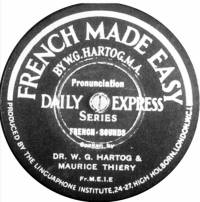The "Vocalion" Fairy records seems to trurn up a lot in Australia and New Zealand, implying this was one of Vocalion's products mainly manufactured for export.
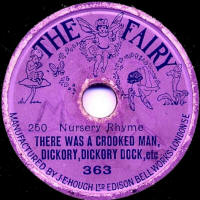
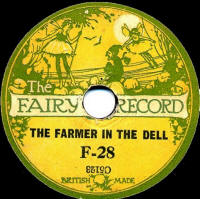
In 1913, Blum fell out with Kalliope due to them pressing records for other clients, but using Blum's exclusive matrices. Subsequent Famous records were still pressed in Germany, but by another manufacturer (so far unidentified, but probably Anker) located in Prussia.
Finally, with the outbreak of WWI in August 1914, Blum had his records pressed by The Disc Record Company of Harrow; these are recognisable by the "British Manufacture" printed on the label. Also, some, if not all the British-made Famous records had a dark purple label, instead of the traditional German green labels.
The catalogue numbers start, logically, at 1 and the highest reported by Frank Andrews is 442, issued in the Autumn of 1914. Blum's British matrix series starts at 1000 or 1001 and runs up into the higher 2000s, but sometimes with a prefix of a 7 or 8 shown on the label.

The records were available in 10" & 12" sizes both single-faced, with 10" also being available in double-faced format. They didn't carry a number common to both sides (i.e. a Catalogue Number) but were ordered by the face number. This was common with German records of this period. The 12" records were described as "Royal" Favorites, but I don't believe the word was ever printed on the actual label.
The art of recording was highly skilled and the recording experts (they weren't called engineers in those days) were very secretive about the equipment. Favorite woulde sent over one or two experts each week (apparently on a Tuesday) to take recordings. The finished wax masters would then be taken back to Germany for processing into finished records, which the company claimed would take under 24 hours.
Vischer moved his agency to 45, City Road, London, EC in late 1906.
In June 1910, there seems to have been a close link-up with the Beka Record Company, and their agent, Otto Ruhl at 77, City Road became also agent for Favorite. Very soon after, Beka was bought by Lindstrõm. Beka's London musical director, Julian Jones was also appointed to the same position at Favorite. However, I understand that Favorite retained the recording rooms at 45, City Road.
In early 1911, 10" Favorite records started showing a Serial Number (common to both sides) on the label. This was printed in the top half of the label, replacing the design just below the label name.The first run of numbers was from No. 001 to 037, but in May they changed the numbering and started at 301. Most of the old catalogue was deleted at this time and the remaining sides were given Serial Numbers from 1 to 300, when re-pressed. Also at this time, Favorite records started supplying master to The English Record Company for issuing on their John Bull records. John Bull had previously been using Beka masters and, because of the nature of the business, needed to maintain the same titles in the catalogue. This required Favorite to make recordings specifically for John Bull, which were not issued on the Favorite label.
From September 1912, Favorite pressed records for Ariel, a record sold by J.G. Graves of Sheffield. Favorite were just one of a number of companies doing this!
In the Autumn of 1912, there was price war in the record industry, mainly started by Lindstrõm when they introduced Coliseum & Scala records selling for just 1/6. Up to that time, 10" popular records were usually 2/6 or 3/-. All records companies had to compete and Favorite introduced Lyric Records selling for 1/6 in November 1912. There were also 12" Lyrics at 2/6. Unfortunately, Columbia claimed use of the name Lyric for records and took out an injunction against Favorite, which led to their Lyric records being withdrawn by April 1913 and replaced by the Philharmonic Record, still at 1/6. These were themselves withdrawn by September 1913 as a result of being undercut by even cheaper records selling at 1/-. At this point, Favorite records were reduced in price from 2/6 to 1/6 to maintain a foothold in the market.
In the summer of 1913, it seems that Lindstrõm (who already owned Dacapo, Fonotipia, Jumbo & Odeaon record labels) also bought, or merged with, Favorite, thought it wasn't until early 1914 that Lindstrõm masters in the 35000-series started occasionaly being used for pressing Favorite records. In August 1914, Favorite were planning new records series, including a Favorite De Luxe record of high-class operatic recordings also also a cheap 1/- label (unnamed). The outbreak of WWI that month stopped all their big plans and all production of Favorite records had to be switched to Lindstrõm's factory in Hertford, England. It would appear that from this point, no further recordings were taken specifically by Favorite (although their address remained at 45, City Road), and the label became just another in Lindstrõm's portfolio, along with Beka, Coliseum, Jumbo & Scala. The label lasted in England until May 1916, with the highest known Serial Number being 976. Frank Andrews tells us that, latterly, W.H. Reynolds was selling Favorite records, which may mean some were pressed by him at the former Disc Record Company factory in Harrow, although all known later issues use Lindström masters, but there are some gaps in the listing of the known issues, and Reynolds was still advertising Favorites into 1917.
Explanation of Side numbers:
Favorite side numbers are in the format n-nnnnn, where n is a number.
The one-character number prefix refers to the record's size; 1 = 10", 2 = 12".
The first number character after the hyphen refers to the country of origin of the recording, as explained below:
<none> = France; 1 = Germany; 2 = Austro-Hungary; 3 = Italy; 4 = Spain & Portugal; 5 = Greece, Turkey & Egypt; 6 = Britain; 7 = Russia & Jewish;
8 = Scandinavia; 9 = Netherlands & Belgium; 10 = Balkan.
Other parts of the world were also represented. Known ones are: 21 = China; 23 = Siam (now Thailand); 43 = Ecuador; 45 = Brazin, 48 = Argentina.
Presumably at least some of the numbers in between were also allocated.
The second number character after the hyphen refers to the type of performance:
1 = marches; 2 = dance music; 3 = other band & orchestra recordings; 4 = instrumental soloists; 5 = male voice; 6 = female voice; 7 = comic songs; 8 = spoken word; 9 = combined voices.
The last numbers are sequentially allocated within each size/country/performace type.
An example (as seen right) is 1-67115. 1 = 10"; 6 = British recording; 7 = comic song; 115 is the 115th comic song recorded in London as a 10" master.
Explanation of matrix numbers:
The matrix numbers (not found on the label, but only inscribed on the record) have a letter suffix which was allocated to each recording expert. The main ones I've seen are -o, -t and -x. Although some of the names of the experts are known, the only one I can link to a letter is Billy Whitlock, who used -x and -y (10" and 12" resepectively). Whitlock was the London expert in 1913 and early 1914. Some of the others experts were Otto Birkhahn (Favorite's chief recorder) and Max Birkhahn (Otto's brother). Each expert had their own numerical series which shown before the suffix.
Other things of note on Favorite record labels:
You may see geometric shapes (usually three) stamped out of the labels, through which the record surface can be seen, though there are quite hard to see as there is little contrast between the black label and the black record. I do not know what these mean and have not seen any research elsewhere.
Also, you may see a date printed on the label on the right, just above the level of the spindle hole. This is in the format of dd.mm.yy or dd/mm yy or similar. This is believed to actually be a recording date. If it isn't, it will be a processing date, which should be a day or two later, so is still a very good guide to the recording date. On some labels, this is shown in arabic characters, but still believed to be translatable to the recording date.
At some point, hopefully soon, I will add some more label design examples.
I have extracted the above information from the research of Frank Andrews and Bill Dean-Myatt. The full unexpurgated details will be found, along with a searchable listing of the UK issues on this label, in the Reference Series booklet no. RS-8 which is published by the CLPGS.
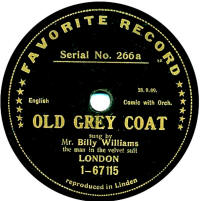
Thanks to Bill Dean-Myatt for providing the label images.
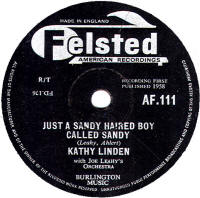
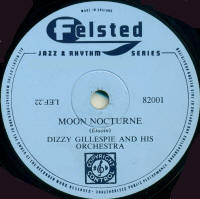
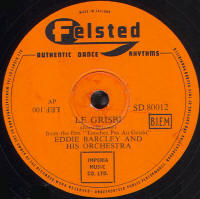
Thanks to Bill Dean-Myatt for providing the label image.
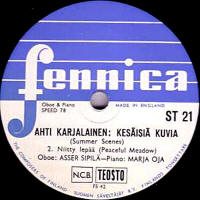
Some mystery surrounds Festival records, in that they were not advertised in trade journals of the time and the prorietor or agent in Britain is not known.
| Cat No | Matrix numbers | Titles | Artists |
| TW-001 |
02125 02126 |
Part 1 - The Journey, part 1:
"In August", "The Relay Song", "The Berlin Train"
Part 2 - The Journey, part 2: "Ballad of Innsbruck", "Pipe March", "Sports March" |
London
Youth Choir London Pipe Band Stella Claydon |
| TW-002 |
02127 02128 |
Part 3 - In Berlin, part 1:
"Festival Calypso"; "Bau Auf" Part 4 - In Berlin, part 2: "Put my name down", "Freedom's song" |
Leon
Fung & London Youth Choir Choir and A London Audience |
Thanks to Dave Mason for the label image and all the information about the known records and the background details.
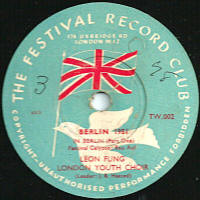
Thanks to Bill Dean-Myatt for providing the label photo.
The earliest Filmophones are pressed from masters obtained from the defunct Dominion Record Company. Filmophone's own recordings were given a master number in the F-1000 series. Recordings from other sources (ususally dubbed) were given a G-1000 series matrix . The F- and G- numbers were separate series. The musical director for the first half of 1931 was bandleader Nat Lewin, but it is not certain who subsequently took over the job.
When Filmophone opened new studios in Marylebone Road in March 1932, the matrix number prefix changed to BT- but continued the existing number series. The company went out of business in July 1932. Filmophone masters may also be found on Hudson and Music Master records, issued after Filmophone's demise.
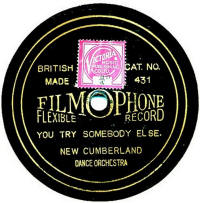
The Flag records don't seem to have been advertised in the trade journals, and it is quite likely it was a "tallyman" record, sold door-to-door under a contract to purchase a fixed number of records over a fixed period (and receive a 'free' gramophone on loan). This would fit with the British patriotic style of other known tallyman labels such as Britannic and John Bull. The Beka Record Co had withdrawn from providing John Bull records in the summer of 1911, so maybe The Flag Records dates from just after that time. This would also fit with the German application for the trade mark which was submitted in December 1911.
Initially the label was black with gold printing, but subsequent pressings sport a white or very pale blue label with red printing, as seen here.
The records were sold by Farley Radio Services Ltd in 1951.
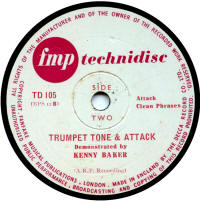
ln April 1906, a British company, Fonotipia Ltd, London, was registered and subsequently took over the Italian company. From later in 1906, Fonotipia records sold in Britiain were manufactured by Crystalate in Tonbridge, Kent.
I would expect Fonotipia records imported for sale in Britain would have had English titling, and certainly those manufactured by Crystalate would have. However, since none of the Fonotipia records I have seen, (which isn't many, to be honest) have English titling I may be wrong.
Any images of British Fonotipia records would be gratefully received!
The 78s were introduced in 1958, with a catalogue series starting at H-101. They were also available as 45rpm records with the same catalogue numbers, but prefixed with '45-'.
The 78rpm issues ran up to at least H-224 issued in December 1959.
My thanks to Bill Dean-Myatt for providing this label image.
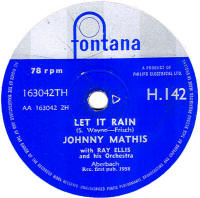
My thanks to Norman Field for providing this label scan.
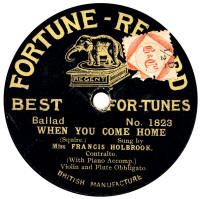
The records date from 1927 and were recorded & manufactured by Parlophone.
They had no catalogue numbers, but just lesson numbers, L.1 to L.26, and Parlophone's WEX- series of matrix numbers.
These records were later issued on the Parlophone Odeon label, on numbers PXO-1000 to PXO-1012.
I would be grateful for a good quality colour image of a label example.
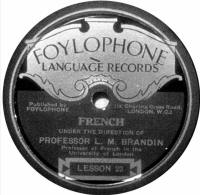

I don't know when these records were made and sold, how many were in the course series, nor who recorded and manufactured them.
A colour scan along with more information would be much appreciated.
